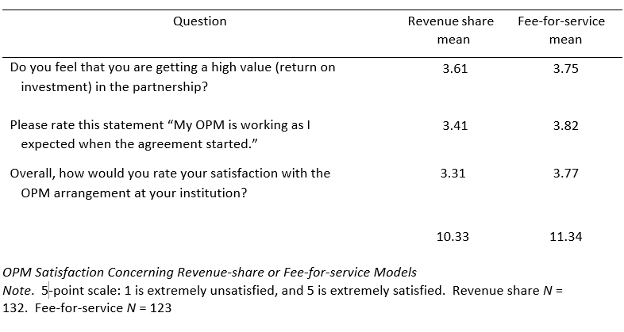You have /5 articles left.
Sign up for a free account or log in.
Mike Graham is vice president of operations and technology at National Louis University. He is also a newly minted Ed.D., having completed his dissertation, “Institutional Satisfaction with Online Program Management (OPM) Providers.”
For a number of years, we have been calling for independent research into nonprofit/for-profit partnerships in the online learning space. Mike’s research begins to address this need. He graciously agreed to answer our questions on his dissertation.
Q: What are the main research questions that you tackle in your dissertation? Can you describe your research methodology?
A: In developing this research, the goal was to begin to understand how institutions looked at their OPM providers. To avoid any conflict with any existing nondisclosure agreements that many OPM providers have institutions sign, I designed a survey that doesn’t look at contract details or ask the respondents to identify their OPM provider.
The three research questions I created focus on determining if there is a correlation between specific characteristics within an institution and OPM satisfaction. These characteristics were by no means all-encompassing, just three that I felt were impactful on the ultimate satisfaction with an OPM relationship from the institution’s perspective. Those characteristics were:
- An individual’s position within the institution
- A comparison between an individual’s assessment of their institution’s ability to market and enroll students
- Institutional revenue available for marketing
The study was a quantitative analysis using Likert-scaled questions. The survey also contained open-ended questions related to the OPMs, and it had questions asking whether COVID-19 had altered the institution’s relation with its OPM provider. I was really pleased with the responses to the survey. I received a large number of responses from presidents and provosts, as well as more operational leadership such as directors of online education. The institutional types from the responses came from a variety of Carnegie classifications, including four-year private and public institutions—both R-1 and teaching.
The survey used Oliver’s expectation confirmation theory (ECT) as the basis for the research. While an older theory, ECT fits the nature of the research I was doing. Essentially, an individual comes to an outsourced relationship with expectations. Whether those expectations are met or not met defines satisfaction.
The results of the answers to the research questions, while statistically significant, had relatively low correlations. For me, that wasn’t the exciting information that came out of this work. I contend that the more interesting results came from the general response to the survey and from other responses that were not a part of my research questions. What caught me by surprise was how many people are still unclear about what an OPM is. After starting the survey, a large number of individuals emailed me asking me if they had an OPM. One respondent suggested that I needed to find a new topic because I had no idea what an OPM was, and then the person proceeded to explain OPMs to me (wrongly).
The ire that this survey brought out in some people was also amazing. I never thought that a topic around a business practice would elicit such anger. There were several quotes like this:
“OPMs are blood sucking leaches (sic) and harm the student experience while ruining the reputation of public institutions.”
To me, the most significant finding in the research was the similarity in the level of satisfaction between revenue share and fee-for-service OPMs. Fee-for-service does have slightly higher satisfaction, but with the negative connotation currently attached to revenue-share OPMs in the United States, the level of satisfaction being so similar is significant.

In response to the question of what OPMs do well, I received responses from several institutions using a revenue-share OPM with answers similar to this:
“The OPM is adept at marketing, enrollment, instructional design, and student support or coaching. They are expert in areas we are not. Additionally they are more easily able to scale up support in areas we are expert in but do not have the financial capability to grow quickly. The OPM does not interfere with academics, that is wholly controlled by the academic departments.”
This is just a brief introduction to some of the research that I found relevant to the discussion of OPMs. If you are interested in reading the entire dissertation, please feel free to visit National Louis University’s Digital Commons website and download it here.
Q: For a university considering working with an OPM on a new online program, what issues does your research illuminate that academic leaders should consider before partnering with an online program management provider?
Recently, much of the dialogue around OPMs has emphasized the superiority of the fee-for-service model as the only model beneficial to higher education. Revenue-share OPMs are seen as greedy corporations taking money from higher education to line their pockets. I fundamentally disagree with this assessment. There is no intrinsic goodness in a fee-for-service company, and one could argue that they have less “skin in the game” than the revenue-share providers. The key to any new relationship is to know what you bring to the relationship and what you want to get out of the relationship regardless of the financial model. From my research (and I will concede I am reading through the lines a bit), institutions that know what they are doing and have clear expectations, regardless of the OPM model, have the best relationships with their OPM provider. The bottom line is that an institution should be clear about why they are engaging and what they can expect. The institution should also realize, as with all things, that positive and/or negative results can emerge.
Along those lines, another interesting finding from the research was how strong the correlations for the questions related to the Oliver model for satisfaction were. Questions in the survey asked respondents how well the OPMs performed in relation to the respondent’s expectations. There was a statistically significant and high level of correlation with these questions. Essentially, what played out was that when an individual had a high level of expectation and the OPM met that expectation, there was satisfaction (which often led to contract renewal).
Another finding that would be beneficial in considering an OPM and was called out repeatedly in the open-ended questions was the efficiency that the OPMs created around university operations. While not a specific goal that institutions had when contracting with an OPM, efficiency in the university’s operations for student-facing areas improved because of the partnership.
A third result that is not necessarily related to OPMs but is potentially significant was the increased use of online education in higher education over the last few years. Unsurprisingly, COVID-19 forced many institutions to move instruction entirely online; some institutions have realized that modality has operated far better than expected and provided an experience that their students prefer. Many institutions indicated an interest in keeping their online offerings in perpetuity, even if they were a more traditional face-to-face institution. The potential for increased competition in the already competitive online space is real.
Q: Do you have any thoughts on how more independent research on nonprofit/for-profit partnerships in the core university area of teaching and learning might be undertaken? How might this research get funded, and in what communities of practice might this research be disseminated and discussed?
There has been a fair amount of research around the “what” of an OPM contract. By that, I mean there have been several excellent reviews of OPM contracts. Both “Dear Colleges: Take Control of Your Online Courses” and the more recent “Examining the OPM: Form, Function, and Policy Implications” do an exceptional job at looking at OPM agreements. Without a doubt, the contracts, particularly around the revenue share model, are long (seven-plus years) and expensive (multimillion-dollar fees). There is also no question that not every OPM company is a good corporate citizen, and some of the contracts were designed to the detriment of the institution. Nevertheless, the picture that has been painted in some quarters is that all revenue-share OPMs are somehow taking advantage of higher education. I don’t believe that is an accurate assessment of the model. First of all, in my opinion, these contractual relationships are not the same as for-profit higher education using unfair practices to extort financial aid dollars from disadvantaged students. Higher education institutions have the most extensive collection of intellectual talent in the United States. They have access to legal counsel. They have boards of trustees charged with protecting the fiduciary interest of the institution. They have accrediting bodies who often look at these agreements. Institutions that sign agreements with pie-in-the-sky promises own the responsibility for that decision.
Furthermore, I think the argument that OPMs cost students more in higher tuition rates misses several points. First, the institutions set the tuition price, not the OPMs. Indeed, a further argument can be made that tuition prices increase because institutions raise rates to offset the revenue share they have to pay (often 50 percent or more of a student’s tuition). Again, that is not an OPM decision. Secondly, the OPM revenue-share model does not look to make money off a single high-paying student. They are a volume play, and as such, they want to find a sweet spot of lower tuition and higher-demand programs, which increases their profits. The math is simple—one $50,000 tuition is less valuable than 10 $30,000 tuitions. So at the risk of sounding like an OPM apologist, we need to closely examine the entire OPM revenue-share model and its role in higher education from many perspectives. My work only scratches the surface of this subject.
Two other research projects have been published studying the OPM phenomenon. Ammar Dallal’s work focuses on graduate schools’ decisions to build or buy (i.e., use an OPM) when launching an online program. Swati Ramani studied the relationship between an institution and its OPM provider in the instructional design process. Finally, I had several people who agreed to be interviewed in a follow-up project about their OPM selection process, their engagement with the OPM and the ultimate institutional satisfaction.
To argue the other side of this coin, OPMs have been tone-deaf, shortsighted, and have repeatedly missed an excellent opportunity. If my whole business model was riding on some very loosely structured federal regulation and there was a safe way to mitigate criticism, I would have taken it. Search Inside Higher Ed and you’ll find stories from Josh Kim and Eddie Maloney calling for OPMs to actively engage with higher education. The OPMs’ continued response has been silence. 2U’s “Framework for Transparency,” while helpful in terms of the information it shares, is not going blunt external criticism. 2U releasing self-selected data in the manner it chooses will never be seen as anything more than self-serving.
When I started my research, I reached out to several larger OPMs and even had several meetings to discuss their participation in my work; ultimately, not one OPM chose to engage with me through the process. In my opinion, this was a huge miss on the part of the revenue-share OPMs, because the story that comes from the data is not that higher education as a whole is dissatisfied with revenue shares. The real story is a mixed bag of institutional satisfaction; perhaps, more importantly, this data comes from someone within the higher education industry. I’m sure there will be people that attack this research and disagree with my conclusions. What cannot be said about this research is that it comes from a source tainted by OPM ownership.
As to the question of funding to continue studying this phenomenon, I’m sure any number of grants that exist might be available. To me, the most imaginative play the OPM industry could make is to commission an external review from scholars who can paint a complete picture of the industry. The OPMs should encourage every client they have to engage with the research and be as cooperative as possible. If my research is any indication, the result will not be that OPM revenue shares are beneficial or detrimental; there will be some good and some bad in whatever comes out. Most importantly, it will start a dialogue and provide validation from scholars in higher education that cannot be brushed aside because the research comes from colleagues in higher education.
The OPM industry’s shortsightedness may very well lead, I believe, to its ultimate (and needless) downfall. The recent 2U stock plummet shows that the revenue-share model may be on a decline that cannot be turned around. That does not just hurt the OPM industry. It also may have a dynamic impact on higher education. In my opinion, HEERF propped up many struggling institutions; revenue-share OPMs might help keep these struggling institutions going. However, if federal regulation changes, that option may no longer exist.
To be clear, I don’t believe the OPM industry cares about higher education or its students. They are in this to make money, period. That does not mean that higher education professionals cannot use OPMs’ knowledge and abilities to benefit our institutions and students. We need to keep our eyes open, but the relationship can be beneficial to higher education as a whole.




